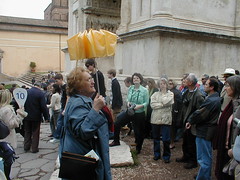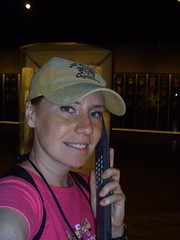 I’m back from a lovely trip to Italy with my girl Cindy. It was a fantastic trip, from the magnificent art of Florence to fun and sun on the Amalfi Coast to the rich history and vibrant present of Rome.
I’m back from a lovely trip to Italy with my girl Cindy. It was a fantastic trip, from the magnificent art of Florence to fun and sun on the Amalfi Coast to the rich history and vibrant present of Rome.
Visiting the ancient city of Pompeii a couple of days ago, it was obvious that we were going to need help navigating around the enormous ruins and understanding the history and culture of Pompeii. We were going to need a guide.
 |
We could of course be our own guides, using expensive guidebooks
available in the bookstore at the entrance. But that would involve
quite a lot of reading and effort, which we weren’t willing to spend.
There were several possible human-guided tours, taking anywhere from
an hour to two-hours, led by guides in Italian, English, Spanish and
many other languages.
The guided tours that we have seen in Italy and elsewhere are now
conducted via radio microphones and receivers, enabling the guide to
speak in a normal voice and be heard by all of their charges clearly.
It has the advantage of keeping interlopers from benefiting from the
guided experience that other people paid for. And it saves the lungs of
the guide from having to shout over other noises in the area.
 |
For those who want a more individualized experience, there are audio
guides available in Pompeii. You rent these handheld units (similar to the one pictured here) that you
punch a number into corresponding to numbers placed at various spots
around Pompeii. From the unit a voice orients you to the site, with instructions on what you should examine more closely and where to walk next.
It’s quite a clever system — much better than the tape recorded
guides which only give you the options of starting, stopping and
rewinding. Still, Cindy and I bored of using the devices after a few
tries. Much of the information was not particularly interesting to us
— about the architectural style of the buildings or the diety a shrine
was dedicated to. And listening to the individual devices was somehow not the
same as us doing the tour together.
Still, the audio guide helped me imagine how tours might be better conducted using ICTs.
Imagine you are visiting some ruins in, say, Guatemala. You go to a
booth where you can choose not only the language of the tour but also
an e-guide to conduct the tour.
You are presented on a computer screen a listing of available
e-guides during the time period you are there. Each person has a photo
and a short description of their qualifications and type of tour they
are able to lead. One person might be a graduate student doing her PhD
on religious structures in Pre-Aztec Central America. Another might be
an archeologist assistant who worked on a dig near the site two years
ago. A third might be a feminist historian specializing in the central
role of women in Latin society throughout various empires and epoques.
Each person would have two prices associated with their tour, one for a
pre-recorded version and another for a live guided tour.
The pre-recorded version would operate like the normal audio guides
work, but with more specialized information tailored to what you are
interested in. The real value-added version would be a live e-guide you
would be directly connected to via cell phone embedded in the device.
The tour would then be led by the actual person in real-time, from
wherever they were at the moment.
The live tour guide would ask you (and whoever else was on the tour
with you) what in particular you were interested in seeing and what you
were most interested in knowing about.
I.e. you might have a feminist scholar explain to you the role of an
average female in the ancient domicile you were visiting. What were her
daily duties? What rights did she have? How much education did she
receive?
Or you might have the archeologist assistant explain to you how they
unearthed this site, and tried to piece together what life might have
been like. He might talk about the process of excavation, archiving and
preservation.
In sum, you would be able to get a tailor-made tour of a site with a
knowledgable guide holding your hand along the way. Even though the
person might be hundreds of miles away.
Using ICTs, you can remove the necessity of the tour guide being
physically present at the site, potentially opening up the field to
hundreds of other people with specialized expertise. Students,
work-at-home moms, and amateur experts could all make themselves
available as e-guides during times when they are free. Their fees might
be scaled based on how in-demand their particular tours are and what
people are willing to pay.
I know that I would pay a lot more for a guided tour led by someone
with unique knowledge that I cared about — i.e. local politics, arts
and culture, and food. You would get the thrill of hearing someone who
cares about the subject matter talk about their field (“This is my
favorite view of the whole valley. Can you imagine what it must have
looked like for the first Aztec settler to come across it?”). You could
ask them questions as you were going along (“Why is this house so much
bigger than the other ones?”) It could be a real conversation.
These were the kinds of techie fantasies going through my sun-adled brain as I wandered lost amidst the ruins of Pompeii.